Public transport information is essential for customers. Here guidance is provided on: types of information, location of and audience for information, making information easily readable, bus stop information sign (‘bus stop flag’), electronic information displays, and wayfinding.
Public transport information is essential for customers. Information provision can:
Information is useful for people taking unfamiliar journeys, which may be associated with anxiety.
In general, the type of information to provide users includes:
Provision of information at a bus stop should carefully consider location and audience.
Place signage so it is intuitive and easy to find. Ideally, it should be visible to people waiting in shelters, but it must not block sight lines between bus drivers and waiting passengers. It is beneficial to locate the sign so passengers are facing the direction of the oncoming bus as they view the sign, particularly with real-time arrival information.
Present information so it is clear for a person unfamiliar with the area such as visitors and newcomers. Consider access needs such as audible assistance and braille (see the figure below).

Signage showing bus stop number in digits and braille. Source: Flow Transportation Specialists.
Following a robust accessibility approach will ensure good outcomes for all travellers, including disabled people. It is good practice to:
The table in the summary of signs and markings by bus stop classification above summarises the type of signage recommended for each type of bus stop and whether the component is essential, recommended or optional. Where items marked essential are not legislative requirements, departures should be approved by the relevant road controlling authority and public transport authority. More details are below the table.
Table: Overview of stop-specific information by bus stop type

Download overview of stop-specific information by bus stop type [PDF, 218 KB]
A bus stop information sign, known as a bus stop flag, shows stop-specific information (for example, the bus stop number, bus stop name, timetable direction of travel, and routes that use the stop). Where possible, mounted this sign on the same pole as the RP-5 (see the figures below).
Signs should be at least 1m from the kerb face and must be mounted perpendicular to the kerb.
At stops in town centres and central business districts, the information sign may take the form of a double-sided plinth, which must be clear of both the pedestrian through path and from the doors of a stopped bus.

Bus stop information sign and RP-5 mounted on a same pole. (Source: Auckland Transport)
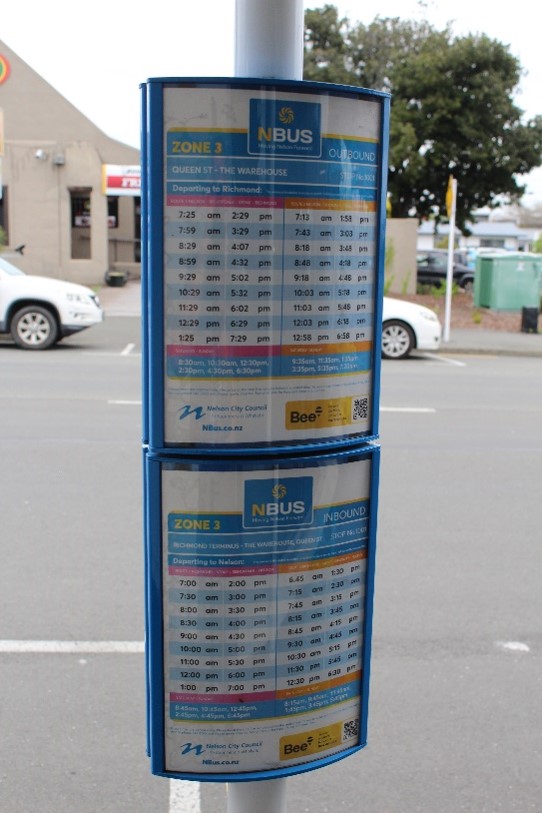
Timetable information mounted on the bus stop information sign. (Source: Mark Edwards)
Electronic information displays (or real-time information) at bus stops are used primarily to give customers up-to-the minute information about when a bus is due to arrive at the stop. They can also provide the public with messages advising of planned service changes or major service disruptions, enabling customers to change their travel plans if necessary.
Real-time information displays are preferable to static displays. Some research[1] indicates that real-time information wait estimates are more than twice as close to actual wait times than timetables alone while perceptions of wait time may be reduced by the presence of real-time information.
Real-time information signs can be installed as stand-alone items (see the figure below) or integrated in bus stop shelters.
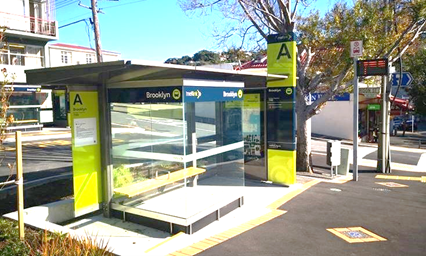
Standalone real-time sign mounted on pole. (Source: Metlink)
The figure below is a real-time sign integrated into a shelter. These signs should be accompanied with an audio button to cater for vision-impaired passengers.
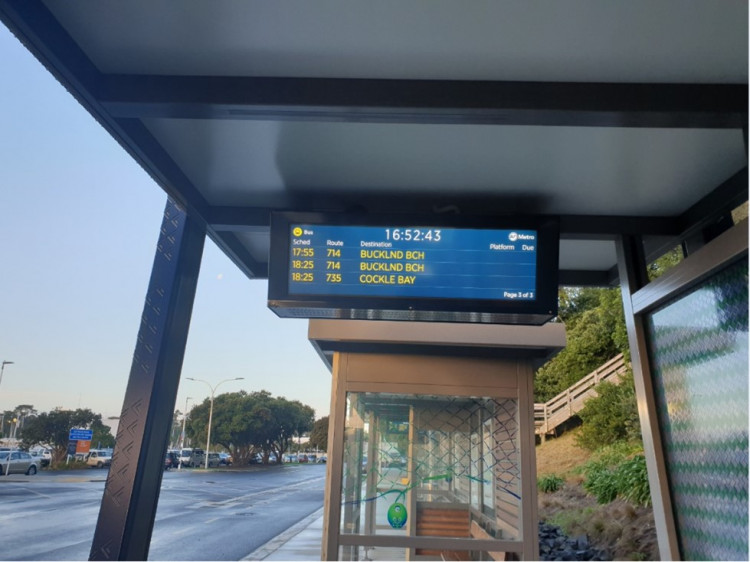
Real-time sign incorporated into a shelter. (Source: Flow Transportation Specialists)
Some installations of real-time displays have been problematic and costly in New Zealand, especially relating to issues such as power supply connections, reliability, and overall cost to operate.
More recent technology developments such as various ‘e-paper displays’ generally offer lower power solutions, including solar solutions, with cloud-based connections making the whole connection task much easier and often cheaper to supply and install (the figures below).
Vandalism is also an issue where display signs are at a reachable height. Consider surveillance and maintenance when considering installing such signs.
When deciding where to provide electronic passenger information displays, give priority to bus stops:
Prioritising these locations will offer more use of the resources per dollar spent, but real-time information is also appreciated by customers on lower-frequency routes where the cost of not knowing when your bus is arriving may be long wait times (for example, 30 minutes). In these locations, if real-time information displays cannot be financially justified, provide signage informing passengers of other ways to obtain real-time information such as phone numbers they can call or text and addresses of apps or websites they can use.
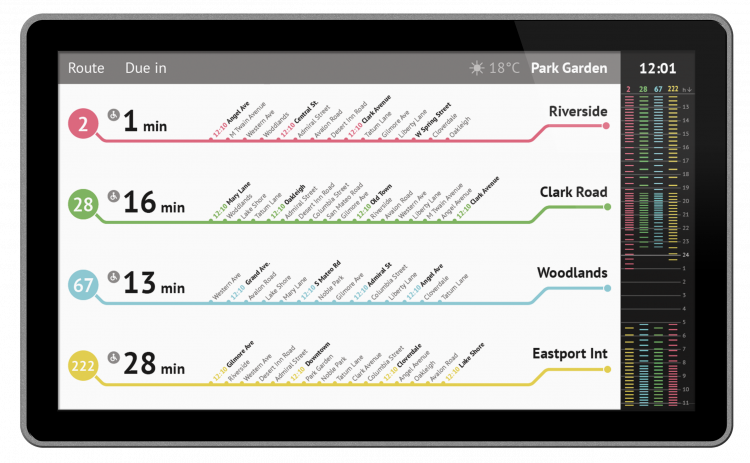
‘E-paper’ real time information display. (Source: Papercast)
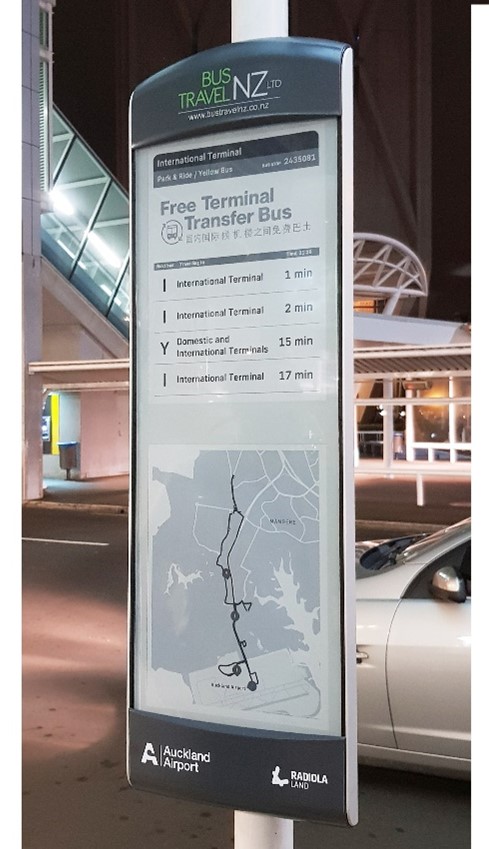
‘E-paper’ timetable at Auckland Airport. (Source: Radiola Land)
Wayfinding is an important element of safety and security by preventing passengers from getting lost and providing confidence that the route continues to the intended destination.
A good wayfinding system:[2]
Consider wayfinding for all bus stop locations and, if possible, integrate it with local street mapping displays and facilities (for example, integrate wayfinding maps and local area maps to assist with journeys outside the bus stop area.)
When developing wayfinding tools consider:
Develop public transport network maps to favour legibility, but remember this can skew distances. Therefore, consider the purpose of map thoroughly in its development to reach the right balance.
See the examples of wayfinding information at bus stops in the figure below.
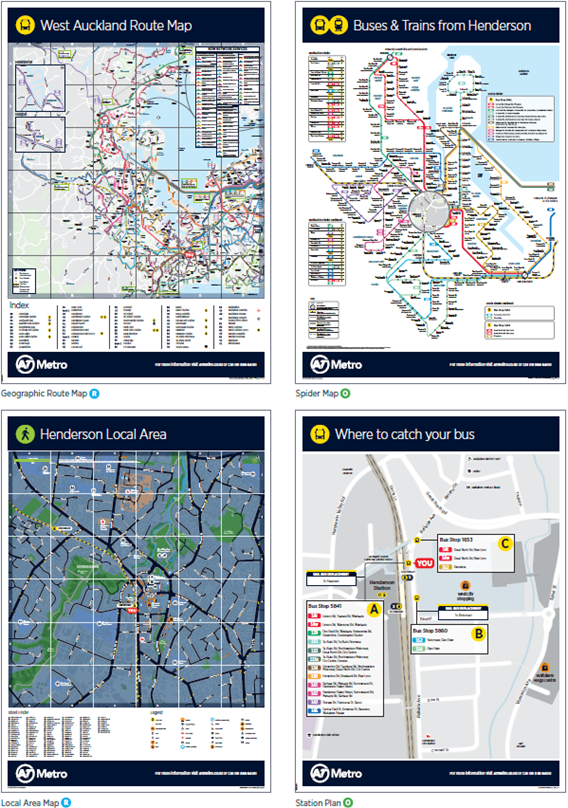
Wayfinding information at unstaffed bus stops and interchanges. (Source: Auckland Transport)
References
[1] O Cats & G Loutos. 2016. Real-time bus arrival information system: An empirical evaluation’, Journal of Intelligent Transportation Systems 20(2), 138–151. DOI: 10.1080/15472450.2015.1011638(external link)
[2] The key elements of a good wayfinding system are adapted from O Cats & G Loutos. 2016. Real-time bus arrival information system: An empirical evaluation’, Journal of Intelligent Transportation Systems 20(2), 138–151. DOI: 10.1080/15472450.2015.1011638(external link)